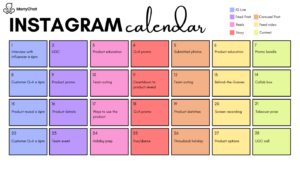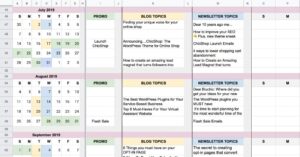
Editorial Calendar versus Content Calendar: A Deep Dive
An effective content strategy relies heavily on organization and planning. Two essential tools in this process are the editorial calendar and the content calendar. While these terms are often used interchangeably, they serve distinct purposes in the content creation process. In this blog, we’ll explore the difference between editorial and content calendars, their roles in content marketing resources, and how they support the content creation process.
What is an Editorial Calendar?
An editorial calendar is a high-level planning tool designed to guide the overall content strategy. It’s used by marketing teams to align content themes with broader business goals and ensure a cohesive strategy.
Key Features of an Editorial Calendar:
- Focuses on long-term goals and overarching themes.
- Highlights content types, such as blogs, videos, or podcasts. Read more about content and content personalization ?
- Aligns with key events, holidays, or product launches.
- Tracks deadlines and assignments for writers or teams.
By providing a bird’s-eye view of your content strategy, the editorial calendar ensures that every piece of content serves a purpose in the broader marketing plan
What is a Content Calendar?
A content calendar, on the other hand, is a more granular tool focused on the specifics of content scheduling and publication. It’s used to organize individual content pieces across platforms and timelines.
Key Features of a Content Calendar:
- Tracks specific publication dates for each piece of content.
- Organizes posts across multiple platforms, such as blogs, social media, and newsletters.
- Includes details like post titles, links, and targeted keywords.
- Provides a framework for content scheduling and coordination.

While the editorial calendar focuses on the “why,” the content calendar focuses on the “when” and “how.”
Editorial Calendar vs Content Calendar: Understanding the Difference
Understanding the difference between editorial and content calendars is crucial for creating a streamlined and effective content creation process:
| Feature | Editorial Calendar | Content Calendar |
|---|---|---|
| Purpose | Guides overall strategy | Manages execution and scheduling |
| Scope | High-level themes and goals | Detailed tasks and timelines |
| Focus | Strategy alignment | Publication specifics |
| Users | Marketing strategists and managers | Content creators and social media teams |
Both tools are indispensable in content marketing, but their combined use ensures a seamless transition from planning to execution.
How to Choose Between Editorial and Content Calendars
When deciding which tool to use, consider your goals and team structure:
- Use an Editorial Calendar if:
- You’re planning long-term strategies.
- You’re coordinating large teams or campaigns.
- You need a big-picture view of content goals.
- Use a Content Calendar if:
- You’re managing daily or weekly publication schedules.
- You need detailed task tracking and coordination.
- You’re focusing on platform-specific content.
In many cases, teams benefit from using both tools in tandem.
How to Build a Content Strategy Around Calendars
Developing a comprehensive content strategy requires integrating both calendars effectively. Here’s a step-by-step approach:
- Define Your Goals: Determine your content marketing objectives, such as brand awareness, lead generation, or customer retention.
- Choose the Right Tools: Use content strategy planning tools like Trello, Asana, or Google Sheets to create your calendars. Read about Ai in marketing
- Map Out Themes and Topics: Use your editorial calendar to plan high-level themes and align them with business goals.
- Schedule and Execute: Populate your content calendar with detailed tasks, publication dates, and platform-specific posts.
- Monitor and Adjust: Regularly review performance metrics and adjust your calendars as needed to improve results.
Why Calendars Are Essential in Marketing
Whether you’re a solo content creator or part of a large marketing team, using marketing calendars helps:
- Enhance productivity by organizing tasks and deadlines.
- Improve consistency in brand messaging.
- Ensure alignment between content and marketing goals.
- Streamline communication within teams.
Top Tools for Managing Editorial and Content Calendars
A variety of content strategy planning tools can simplify the process of creating and managing calendars. Here are some popular options:
- Trello: Ideal for visual task management and collaboration.
- CoSchedule: Combines editorial and content calendar features for marketing teams.
- Google Sheets: A versatile and budget-friendly option for custom calendar creation.
- Asana: Great for detailed task tracking and team coordination.
These tools offer features that cater to both editorial planning and content scheduling, making them invaluable for content marketers.
Conclusion
Both the editorial calendar and content calendar are indispensable tools in modern content marketing. By understanding their differences and leveraging them effectively, you can enhance your content creation process, align with your business goals, and streamline your marketing efforts. Whether you’re focusing on strategic planning or detailed scheduling, the right calendar ensures that your content strategy stays on track.




